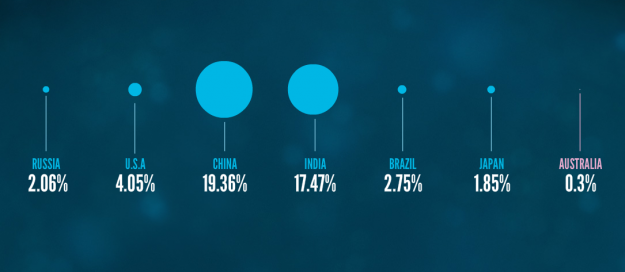Call it the gift that keeps on giving (if one is a corporation that is): the US Tax system, so effective at extracting income tax from America's working class, is just as "effective" at redistributing said income tax at the corporate level. Case in point: News Corp, which after generating $10.4 billion in profits over the past 4 years, and which would have been expected to pay the IRS $3.6 billion at the statutory corporate tax rate, instead received $4.6 billion back from Uncle Sam. Bottom line: Murdoch's corporation had a cash paid tax rate of -46% between 2007 and 2010. The culrpit: two little somethings called Deferred Tax Assets and Net Operating Loss Carry-forwards.
The chart below shows News Corp's profits and annual cash tax receipts.

Is it all just such IRS tax loopholes as deferred tax assets and NOL carryforward? Not entirely. Reuters explains:
How does Murdoch make money off the tax system? There are three basic elements, disclosure statements show.
One is the aggressive use of intra-company transactions that globally allocate costs to locations that impose taxes -- and profits to areas where profits can be earned tax-free.
For that Murdoch can thank laws and treaties that treat multinational corporations much more generously than working stiffs, such as those who make up the audience for his New York Post and for his British tabloids with bare-breasted women. Working stiffs have their taxes taken out of their pay before they get it, while Murdoch gets to profit now and pay taxes by-and-by.
News Corp. has 152 subsidiaries in tax havens, including 62 in the British Virgin Islands and 33 in the Caymans. Among the hundred largest U.S. companies, only Citigroup and Morgan Stanley have more tax haven subsidiaries than News Corp., a 2009 U.S. Government Accountability Office study found.
News Corp. had nearly $7 billion permanently invested offshore in 2009, money on which it does not have to pay taxes unless it brings the money back to the United States. Meanwhile, it can use that money as collateral for loans in the United States, where interest paid is a tax-deductible expense.
Granted, this practice accounts for a very modest portion of the total tax receipts. The two far greater culprits are acquired NOLs...
Buying companies with tax losses is a second way Murdoch can pocket, rather than pay, taxes. In three deals to acquire American television stations -- in 1985, 1990 and 2001 -- questions were raised about whether Murdoch entities were in compliance with American rules limiting the ownership stakes of foreign investors.
A memo, turned over to the Federal Communications Commission during one of these inquiries, showed that in 1990 Murdoch's advisers were, in the words of Michael Gardner, an outside counsel to News Corp., "in agreement that it is paramount to avoid any corporate restructuring which would potentially invite reexamination of Fox TV's ownership structure" by the FCC.
In 1995, the FCC general counsel, William Kennard, said that a two-year investigation requested by rival NBC and the National Association for the Advancement of Colored People (NAACP) found that "Fox did not clearly or explicitly disclose" News Corp.'s ownership stake in American television stations as required. However, Kennard said this lack of candor was insufficient to require a hearing into whether Fox had intended to deceive the commission.
... and, yes, deferred tax assets:
Murdoch's tax lawyers are expert at maximizing the benefits of deferrals. Incurring a tax today, but paying it by-and-by can be profitable. A dollar of tax deferred for 30 years, and invested at 8 percent real growth while inflation runs 3 percent, is worth more than $10 at the end of the period, while the real value of the tax when it is ultimately paid is just 40 cents.
Last year News Corp. had net future tax assets of $3.3 billion. In the past four years News Corp. has either used up a lot of its tax benefits or had them expire. In 2007 its net tax assets were $5.7 billion.
At this point Reuters takes a rare departure from its dry factual reporting to poke some fun at the billionaire, whose empire, and reputation, is suddenly crumbling before his eyes:
Fox News, the editorial pages of his Wall Street Journal and other Murdoch outlets often rail against taxes. Their attacks on government benefits for the elderly, the sick, the jobless and children focus attention on the uses of tax dollars and away from his aggressive efforts to enjoy the benefits of civilization without paying for them.
Many other companies may follow similar practices but most of corporate America doesn't own one of the country's most powerful newspaper editorial pages.
...
Murdoch assiduously courts the powers-that-be for favorable laws and regulatory rulings. Contrast that with the rough and sometimes relentless attacks on politicians and government programs of his newspapers and his Fox News Channel.
Murdoch's news outlets can prove enormously helpful to politicians. His support boosted Hillary Clinton's 2000 campaign for the U.S. Senate from New York, helping her to beat Republican Rick Lazio. Murdoch even hosted a Clinton re-election campaign fundraiser in 2006, while restraining New York Post gossip mongers who looked on her husband as red meat in the White House.
Murdoch gets invited to weddings and celebrations of top American, British and Chinese officials. He flew Tony Blair halfway around the world to a company event in Australia when the future British prime minister was opposition leader.
Imagine how well Jesus might have done if he had put a corporate jet at Caesar's disposal. Or if he had a tabloid like the News of the World to put Caesar in fear of him.
However, in the interest of objectivity, News Corp. is merely one of many corporate transgressors who take full advantage of the massive loopholes in America's tax code. From Bloomberg.
American International Group Inc. (AIG), Citigroup Inc. (C) and General Motors Co. (GM), once the largest insurer, bank and automaker, hold a new distinction after losses forced them to take bailouts. The firms accumulated some of the biggest deferred tax assets that may lower obligations to the government that rescued them.
Losses at New York-based AIG and its subsidiaries helped rack up more than $25 billion in the assets. That’s worth more to AIG’s share price than its plane-leasing business with 933 aircraft, according to Bank of America Corp.
“They’re in the same class of GM and Citigroup in terms of the largest I’ve ever seen,†Robert Willens, an independent tax consultant in New York, said of AIG. “Any one of them is in the hall of fame of large deferred tax assets.â€
Citigroup’s $23.2 billion of carry-forwards as of Dec. 31 include benefits from net operating losses and foreign tax credits. The New York-based bank expects to use its entire U.S. federal net operating loss carry-forward this year, according to a regulatory filing. The company valued that asset at about $3.9 billion at the end of last year. Jon Diat, a spokesman for Citigroup, declined to comment.
GM reported $20.1 billion in tax carry-forwards. The automaker amassed tax assets as it posted losses from 2005 to its bankruptcy in 2009, and in some regions outside the U.S. last year. GM is poised to become the No. 1 automaker by sales this year after being passed in 2008 by Toyota Motor Corp.
The sum means the company may not pay taxes to the U.S. until 2018, Adam Jonas, a Morgan Stanley analyst, said in a July 6 research note. Jonas, who swapped GM for Ford Motor Co. as his top U.S. auto pick in the report, said the assets are worth about $9 per share, more than the value of the company’s joint ventures in China. Jim Cain, a spokesman for GM, declined to comment.
As a reminder...
AIG was rescued in 2008 in a bailout that swelled to $182.3 billion. Citigroup received $45 billion from the Treasury’s Troubled Asset Relief Program and $301 billion in guarantees on its riskiest assets. The government sold its remaining stake in the bank in December.
GM was bailed out with $49.5 billion in taxpayer funds as the government backed its bankruptcy in 2009. The Treasury reduced its stake to 33 percent last year in a share sale.
It is probably only fitting that companies that have received massive taxpayer generosity to remain in business continue their tax evasive ways and pay absolutely nothing in cash taxes (and probably, quite the inverse) for years and years. After all, who needs corporate cash: there is always the Fed's printing press to make up for any shortfalls. And non-sheltered, middle-class income tax of course.
























